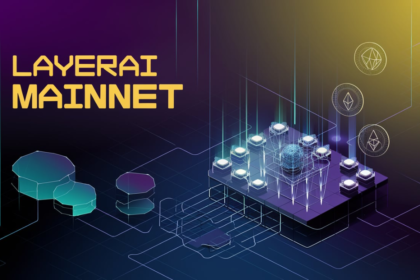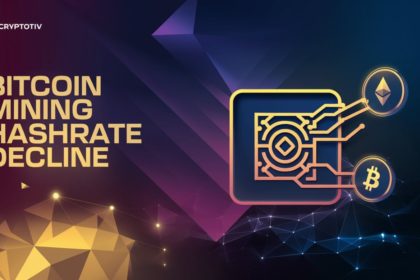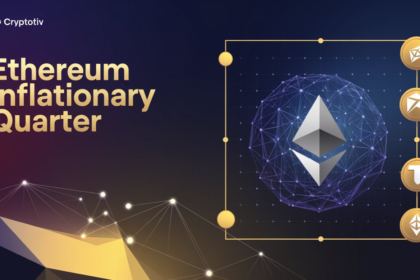The EOS Spring 1.0 upgrade represents a pivotal moment for the blockchain industry, introducing the Savanna consensus algorithm. This hard fork has significantly enhanced the EOS Network by reducing transaction finality to just one second. With this upgrade, EOS improves its network’s scalability, security, and overall user experience. As one of the few Layer 1 blockchains to implement such a shift in consensus, EOS is set to play a leading role in the future of blockchain innovation.
Key Features of the EOS Spring 1.0 Upgrade
The EOS Spring 1.0 upgrade has brought several transformative features to the EOS Network. These upgrades focus on improving the network’s efficiency, security, and overall performance. The most prominent change is the introduction of the Savanna consensus algorithm, which has dramatically enhanced transaction speed and finality. Additionally, the inclusion of aggregate BLS signatures has boosted network security, setting the stage for future scalability and the growth of decentralized applications (dApps) on the EOS blockchain.
Instant Transaction Finality with Savanna Consensus
With the implementation of the Savanna consensus algorithm, the EOS network has achieved a significant milestone by reducing transaction finality from several minutes to just one second. This improvement allows transactions to be completed almost instantaneously, vastly enhancing the user experience. Previously, users had to wait several minutes for transactions to be confirmed, but now, thanks to Savanna, EOS offers near-instant finality. This advancement makes EOS an ideal platform for developers building high-performance decentralized applications, particularly those requiring fast and reliable transaction processing.
Enhanced Security Through Aggregate BLS Signatures
One of the major security advancements in the Spring 1.0 upgrade is the integration of aggregate BLS signatures. This cryptographic innovation enables multiple signatures to be combined into a single signature, reducing the computational load on the network. As a result, transactions are processed more efficiently while maintaining robust security measures. The enhanced security protocols ensure that the EOS network is more resilient against attacks.
Here is a comparison table showing the security and performance improvements before and after the upgrade:
| Feature | Pre-Spring 1.0 | Post-Spring 1.0 |
|---|---|---|
| Transaction Finality Time | Several minutes | 1 second |
| Security Protocol | Standard Signatures | Aggregate BLS Signatures |
| Transaction Processing Speed | Slower due to individual verifications | Faster with combined signatures |
Scalability Improvements for Decentralized Applications
The Spring 1.0 upgrade has also brought significant scalability improvements to the EOS network, making it better equipped to handle the demands of large-scale decentralized applications (dApps). By increasing the network’s ability to process transactions faster and more securely, the upgrade enhances developer capabilities. This means developers can build more complex and resource-intensive applications without facing scalability issues.
Note
The upgrade positions EOS as a leading platform for dApps, which can now enjoy faster transaction throughput and better overall performance.
Recommended paths for you:
- Understanding the Benefits of Blockchain Scalability
- Top Blockchain Security Practices for Developers
- The Role of Consensus Algorithms in Blockchain Governance
- EOS Network Enhancements and Developer Tools
- The Future of Decentralized Finance on EOS
Structural Changes and Governance Enhancements
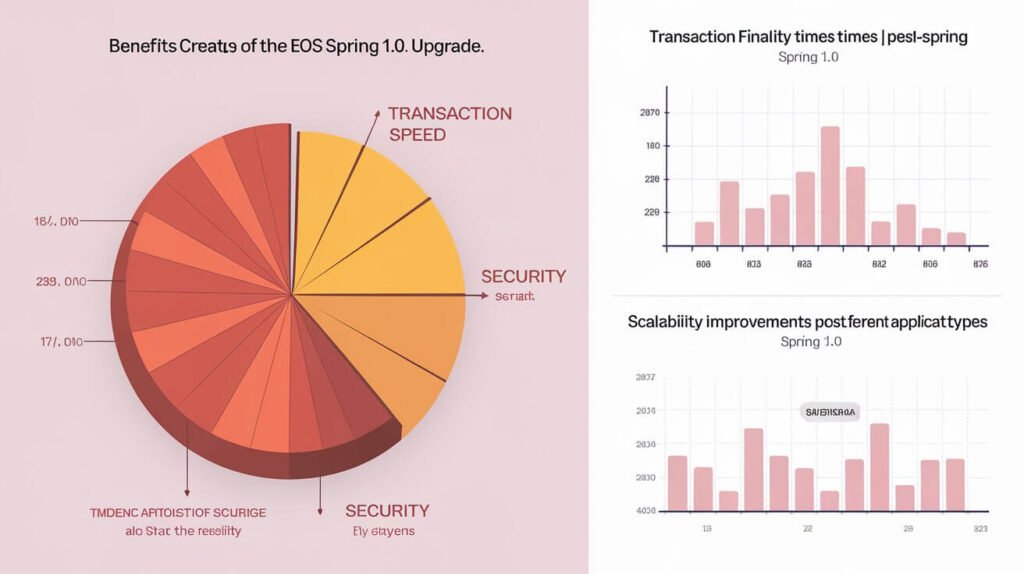
The EOS Spring 1.0 upgrade has introduced significant governance and structural improvements, paving the way for a more decentralized and flexible EOS network. These changes aim to enhance the network’s decentralization and improve overall management, ensuring that the EOS blockchain remains resilient and adaptable to future growth and challenges. One of the most noteworthy structural updates involves the potential separation of the block producer roles, which offers the community more options in how the network is governed and managed.
Separation of Block Producer Roles
One of the key innovations introduced in the Spring 1.0 upgrade is the potential future separation of block producer responsibilities into two distinct roles: Block Proposers and Block Finalizers. Currently, block producers handle both proposing and validating blocks, but with this separation, the EOS network could become more efficient and decentralized. Block Proposers would be responsible for assembling transactions into blocks, while Block Finalizers would focus on confirming and finalizing the proposed blocks, providing additional layers of security and verification.
This potential shift allows for decentralized block validation, reducing the concentration of power within the network. By splitting these responsibilities, the system could become more robust and adaptable to future challenges, enhancing the network’s resilience. Additionally, this change could increase the participation of community members in key decision-making processes, reinforcing EOS’s commitment to community-driven governance.
Impact on Network Decentralization
The Spring 1.0 upgrade not only enhances the efficiency of block production but also has a profound impact on the decentralization of the EOS network. By giving the community more control over the governance structure and introducing new roles, the network becomes less reliant on a small number of block producers. This structural shift allows for greater flexibility, making the EOS blockchain more scalable and resilient to potential threats.
The move toward decentralization strengthens the security and integrity of the EOS blockchain by distributing responsibilities more evenly across the network. This change ensures that no single entity can dominate the validation process, reducing the risk of centralized control and making EOS a more attractive platform for developers and enterprises focused on building decentralized applications(dApps).
Cryptographic Advancements and Privacy Enhancements
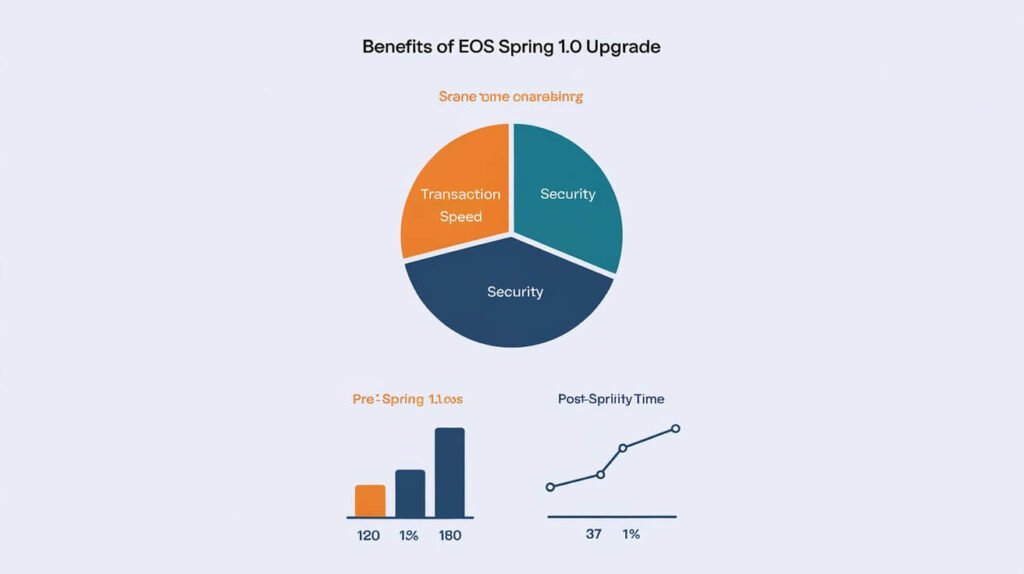
The EOS Spring 1.0 upgrade brings forward significant cryptographic advancements aimed at strengthening privacy and security on the blockchain. These innovations not only enhance the performance of the EOS network but also set the stage for future privacy-driven applications. One of the most critical features introduced in this upgrade is BLS cryptography, which lays the foundation for potential Zero-Knowledge (ZK) proofs, ensuring a more secure and privacy-resilient network.
BLS Cryptography and Zero-Knowledge Proofs
One of the core cryptographic advancements introduced in the Spring 1.0 upgrade is the implementation of BLS (Boneh-Lynn-Shacham) cryptography. BLS signatures allow multiple signatures from different users to be combined into a single compact signature, significantly improving the efficiency of transaction processing. This feature not only enhances transaction speed but also strengthens the network’s security by ensuring that the verification of signatures is both faster and more reliable.
Moreover, introducing Zero-Knowledge (ZK) proofs is an exciting development in the field of blockchain privacy. ZK proofs enable the verification of certain information without revealing the underlying data itself. This method could prove crucial for privacy-sensitive applications, such as decentralized finance (DeFi) and identity verification, where users may want to keep their transactional details confidential while still participating securely on the blockchain(.
Confidential Transactions and Private Addresses
The Spring 1.0 upgrade also paves the way for confidential transactions and private address usage on the EOS network. Confidential transactions allow users to transact without revealing the details of the amounts involved. This technology leverages advanced cryptographic methods, ensuring that while the transaction itself is visible on the blockchain, the specific details remain hidden from the public. This level of privacy is vital for users and organizations that prioritize the confidentiality of their financial data.
Additionally, the potential introduction of private addresses allows for further anonymity and security within the EOS ecosystem. By using private addresses, users can engage in blockchain transactions without disclosing their identity, which is essential for maintaining privacy in decentralized environments. These advancements position EOS as a frontrunner in addressing the growing demand for privacy-enhancing features in the blockchain industry.
Developer Tools and Ecosystem Growth

The EOS Spring 1.0 upgrade introduces a range of new features and tools that significantly enhance the developer ecosystem. By improving the speed and scalability of the network, the upgrade provides developers with a more efficient environment for building and deploying decentralized applications (dApps). The focus on smart contract efficiency and faster transaction finality ensures that EOS remains a competitive and attractive platform for blockchain developers worldwide.
Improved Developer Tools and Resources
One of the major benefits of the Spring 1.0 upgrade is the introduction of improved developer tools that streamline the process of building on the EOS network. With faster block production and the reduction of transaction finality to just one second, developers now have access to an environment that supports real-time dApp interactions. These improvements simplify the deployment of scalable decentralized applications, making the network more efficient and developer-friendly.
Moreover, the enhanced smart contract functionality introduced with the upgrade provides developers with greater flexibility when creating blockchain solutions. These updates not only improve the speed and reliability of smart contracts but also make it easier for developers to integrate decentralized finance (DeFi) applications and other complex dApp ecosystems.
Boosting Ecosystem Growth and dApp Development
The Spring 1.0 upgrade is poised to foster significant ecosystem growth, making EOS a more appealing platform for developers seeking to create robust and scalable dApps. By improving transaction throughput and scalability, the network now supports the development of high-performance applications that can handle large transaction volumes without compromising on speed or security.
advancements are expected to lead to an increase in dApp development on EOS, as developers will be able to build more resource-intensive applications with ease. Additionally, the enhanced security protocols introduced in the upgrade ensure that developers can trust the network to protect their applications from security vulnerabilities.
Here’s a quick checklist of the key benefits for developers:
- Faster transaction finality.
- Improved scalability for dApps.
- Enhanced security protocols for decentralized applications.
- Target Keywords: EOS ecosystem growth, blockchain dApp development.
Implications for the Future of EOS
The EOS Spring 1.0 upgrade is not merely a technical improvement but a fundamental step that positions EOS for future growth and wider adoption across the blockchain industry. With advancements in transaction speed, security, and scalability, the upgrade opens up new opportunities for developers and users, allowing EOS to serve as a robust platform for next-generation decentralized applications (dApps). These improvements have the potential to reshape how developers build on EOS and how businesses utilize blockchain solutions.
Unlocking New Use Cases for Blockchain Applications
The EOS Spring 1.0 upgrade significantly expands the network’s capacity to support new use cases across various industries. With faster transaction finality and enhanced scalability, EOS is now better equipped to host Decentralized Finance (DeFi) applications, which require high transaction throughput and secure environments. Developers in the DeFi space can leverage EOS’s improved performance to build more complex and secure applications that handle large volumes of financial transactions.
Additionally, the upgrade paves the way for blockchain-based gaming, where seamless and real-time interactions are crucial. EOS’s enhanced capabilities enable developers to create more interactive gaming experiences that benefit from low-latency transactions and improved scalability.
Note
Other potential use cases include identity verification, supply chain management, and digital rights management, each benefiting from the network’s increased efficiency and security.
Strengthening EOS’s Competitive Edge in the Blockchain Space
The Spring 1.0 upgrade strengthens EOS’s position as a leading platform in the blockchain industry by addressing the key challenges of speed, scalability, and security. By achieving one-second transaction finality, EOS now offers one of the fastest and most efficient blockchain solutions, surpassing many other Layer 1 blockchains in terms of performance.
Note
EOS is an ideal platform for developers looking to build applications requiring real-time interactions and high throughput, such as decentralized exchanges (DEXs) and high-frequency trading platforms.
EOS’s commitment to enhanced security, scalability, and flexibility positions it as a leader in the blockchain space, especially in comparison to other platforms like Ethereum. With its ability to support large-scale dApps and DeFi projects, EOS is likely to attract more developers and enterprises seeking a blockchain solution that can scale efficiently without compromising on security. The upgrade also enhances EOS’s ability to compete in sectors like finance, gaming, and enterprise-level blockchain applications, giving it a solid foundation for future growth
Moreover, the improved security protocols and the potential for future cryptographic advancements, such as Zero-Knowledge (ZK) proofs, give EOS a competitive edge in industries where privacy and data security are paramount. These innovations position EOS as a viable competitor in sectors that demand both high performance and robust security, solidifying its place as a leader in the blockchain space.
The EOS Spring 1.0 upgrade has positioned the network as a leading player in the blockchain space, delivering faster transaction finality, enhanced security, and increased scalability. These improvements open new doors for decentralized finance (DeFi), gaming, and other blockchain applications, ensuring that EOS remains competitive in the industry. With robust cryptographic advancements and tools for developers, EOS is set to drive future growth and innovation.













